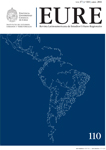Diferenciación sociodemográfica del espacio urbano de la Ciudad de México
DOI:
https://doi.org/10.4067/S0250-71612011000100001Palabras clave:
desigualdad social, fragmentación urbana, metropolización, segregación, transformaciones socioterritorialesResumen
El objetivo de este análisis es establecer una diferenciación socio-demográfica del espacio urbano de la Ciudad de México a partir de un metodología que presenta dos principales aportes: el primero es que se aplica una clasificación geodemográfica que muy pocas veces se usa, basada en estilos de vida o niveles socioeconómicos que tienen su origen en la geodemografía o geomárketing; y en segundo lugar, se usa información censal altamente desagregada a nivel de manzana que en muy pocos estudios se han llevado a cabo; como parte de los resultados se identifican seis clusters y se calculan varios índices de segregación residencial. Lo anterior se elabora tomando como referencia los estudios de segregación residencial que se han llevado a cabo en América Latina y en México. Las conclusiones dan cuenta de cómo en la Ciudad de México se notan rasgos del modelo tradicional de segregación, como la persistencia de las élites en ciertos espacios, y cómo los estratos proletarios y las clases medias han tenido una marcada dispersión, junto a la localización periférica de los grupos pobres, más en sintonía con las propuestas del actual modelo de dispersión y fragmentación del espacio urbano.
Descargas
Publicado
Cómo citar
Número
Sección
Licencia
Derechos de autor 2011 Revista EURE - Revista de Estudios Urbano Regionales

Esta obra está bajo una licencia internacional Creative Commons Atribución 4.0.
Al momento de aceptar la publicación de sus artículos, los autores deberán formalizar la cesión de derechos de autor a EURE, según las condiciones establecidas por la Revista.
Ésta establece que el autor autoriza a EURE de manera gratuita, exclusiva e ilimitada a reproducir, editar, publicar, distribuir, publicitar, comercializar y traducir el artículo, a cualquier soporte conocido o por conocer y desarrollar.
Del mismo modo, los autores aseguran que el artículo propuesto es original, no publicado y no propuesto para tal fin a otro medio de difusión.


